15 Beautiful & Practical Raised Garden Bed Ideas for Your Backyard!

Raised garden beds have become a favorite among gardeners, and it’s easy to see why.
Whether you’re a seasoned green thumb or just starting out, they offer a host of benefits—from better soil control to easier access for maintenance.
Their versatility and aesthetic appeal make them a great addition to any outdoor space.
If you’re looking for creative ways to integrate raised beds into your garden, we’ve compiled 15 inspiring ideas to help you grow a beautiful and functional garden.
15 Raised Garden Bed Ideas
1. Salad Garden Bed

Plant lettuce, kale, spinach, and Swiss chard to create a fresh, everyday salad mix right in your backyard.
These leafy greens are rich in vitamins and minerals, making them a fantastic choice for healthy eating.
This setup is not only packed with nutrients but also a feast for the eyes as the greens grow in vibrant, textured clusters that bring life to your garden.
By harvesting leaves at different times, you can ensure a steady supply of fresh produce throughout the growing season.
Plus, growing your own salad greens saves money, reduces waste, and eliminates the need for single-use packaging. It’s a win for your health, wallet, and the environment!
2. Herbal Tea Garden
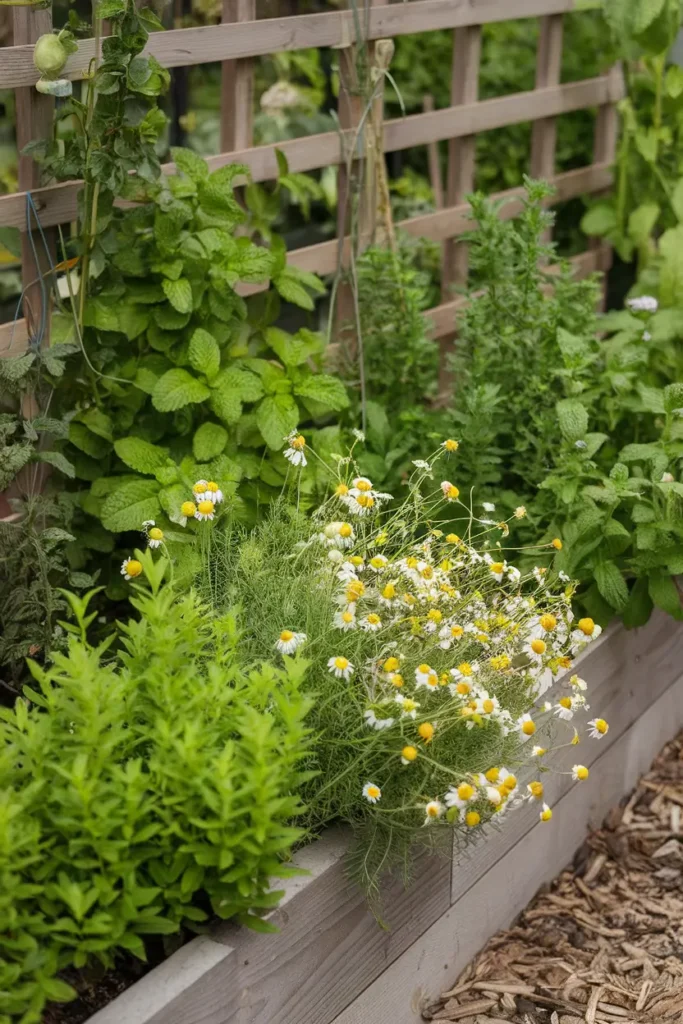
Dreaming of crafting your own herbal tea blends? Dedicate a raised bed to chamomile, lemon balm, mint, and stevia to grow a selection of herbs that are as versatile as they are flavorful.
These herbs are easy to cultivate, even for beginner gardeners, and offer a creative way to enjoy health benefits and flavor with every sip.
Brew them fresh for a soothing tea or dry them to store for later use during colder months.
You can experiment with unique combinations like mint and lemon balm for digestion or chamomile and stevia for a naturally sweet relaxation tea.
This raised bed will not only nourish your body but also fill your garden with delightful fragrance and a calming charm.
3. Window Box Herb Garden
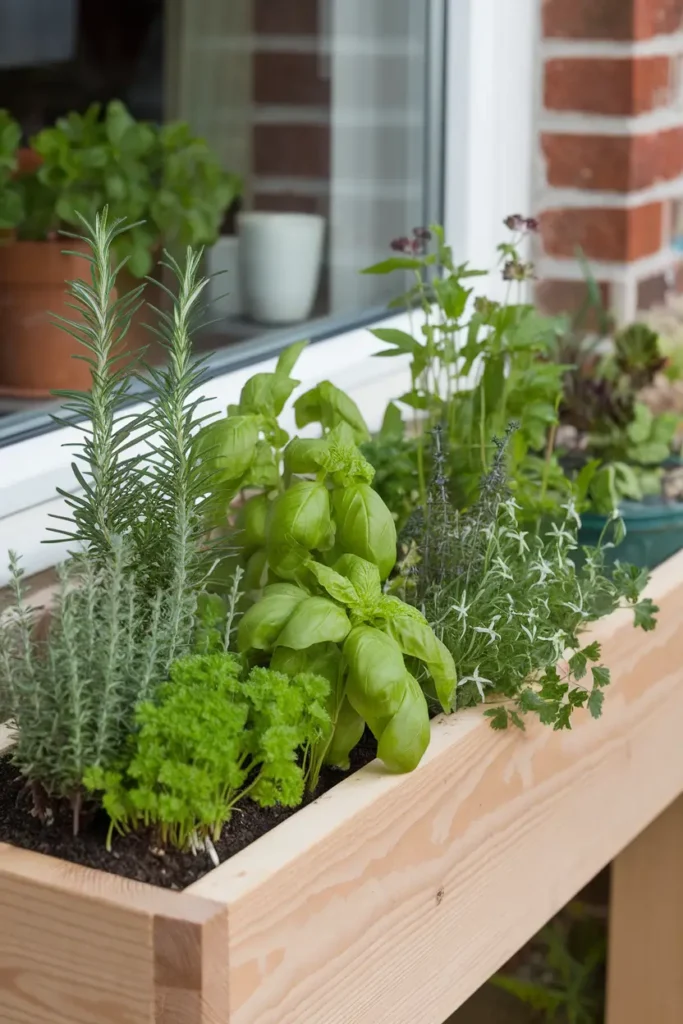
Perfect for small spaces, a window box-style raised bed is a practical and stylish solution for urban gardeners. Place it just outside your kitchen window for quick access to fresh herbs like rosemary, basil, thyme, or parsley.
Imagine snipping fragrant herbs to garnish your dishes without even stepping outside!
These window boxes are a convenient, space-saving option that brings the garden right to your fingertips.
They’re great for apartments, small houses, or anyone looking to maximize their gardening space.
Plus, the sight of vibrant green herbs thriving in a window box adds a touch of freshness and beauty to your living space.
4. Companion Planting Bed
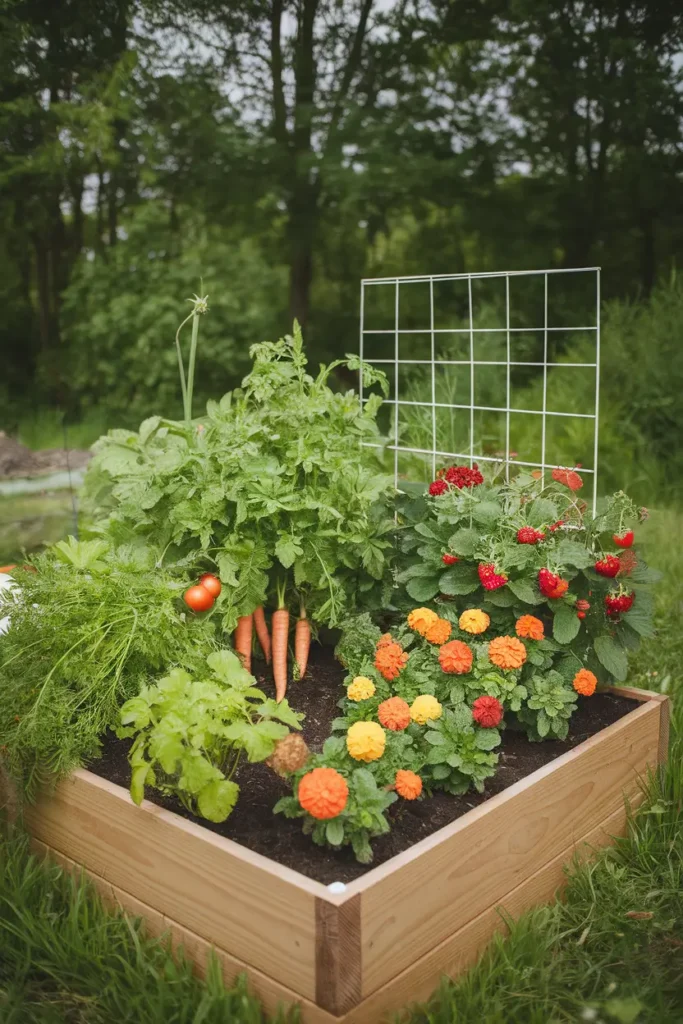
Combine plants that thrive together to create a productive and harmonious raised bed that benefits both your garden and the environment.
Pairing plants such as tomatoes and carrots or strawberries and marigolds helps maximize your growing space while naturally deterring pests and improving soil health.
For example, marigolds can ward off nematodes and other harmful pests, while tomatoes and carrots complement each other’s growth patterns.
This method is ideal for gardeners who want to grow a variety of plants while maintaining a balanced and eco-friendly garden ecosystem.
Plus, companion planting reduces the need for chemicals, promoting a healthier and more sustainable way of gardening.
5. Pizza Garden

Love Italian food? Transform your garden into a pizza lover’s paradise by creating a pizza-themed raised bed. Plant basil, oregano, tomatoes, peppers, and even garlic—all the essential ingredients for the ultimate homemade pizza.
Everything you need will be right in your backyard, ready to inspire your cooking. Imagine plucking fresh basil for a burst of flavor or harvesting juicy tomatoes for a homemade tomato sauce.
This themed garden not only adds a fun and creative touch to your outdoor space but is also a great way to get kids excited about gardening and eating fresh, homegrown ingredients.
Let your garden fuel your culinary adventures and bring a taste of Italy to your kitchen!
6. Rustic Wicker Beds
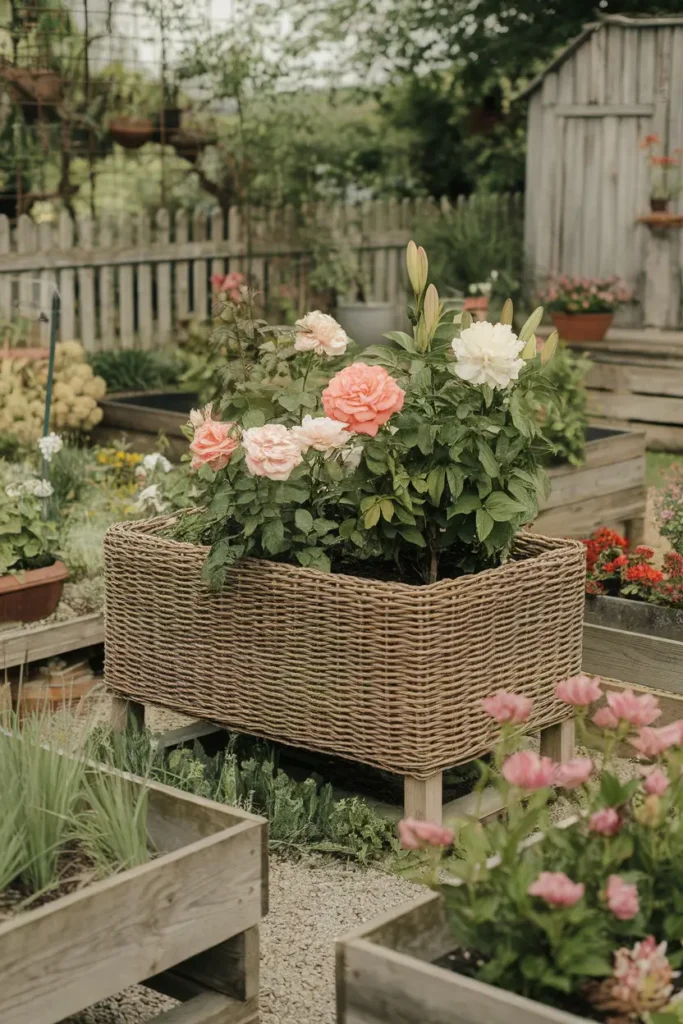
For a charming cottage aesthetic, use wicker frames to create rustic raised beds that bring character and charm to your garden.
These beds work well for vegetables, flowers, or herbs and blend beautifully into a natural garden landscape.
Wicker frames are not only visually appealing but also lightweight and easy to move, making them a practical and versatile option for gardeners who like to change their setups.
Whether you’re growing colorful blooms, aromatic herbs, or nutrient-rich vegetables, these rustic beds bring functionality and style together.
They’re perfect for creating a cozy, inviting garden that feels like a step back in time.
7. Lavender Companion Garden
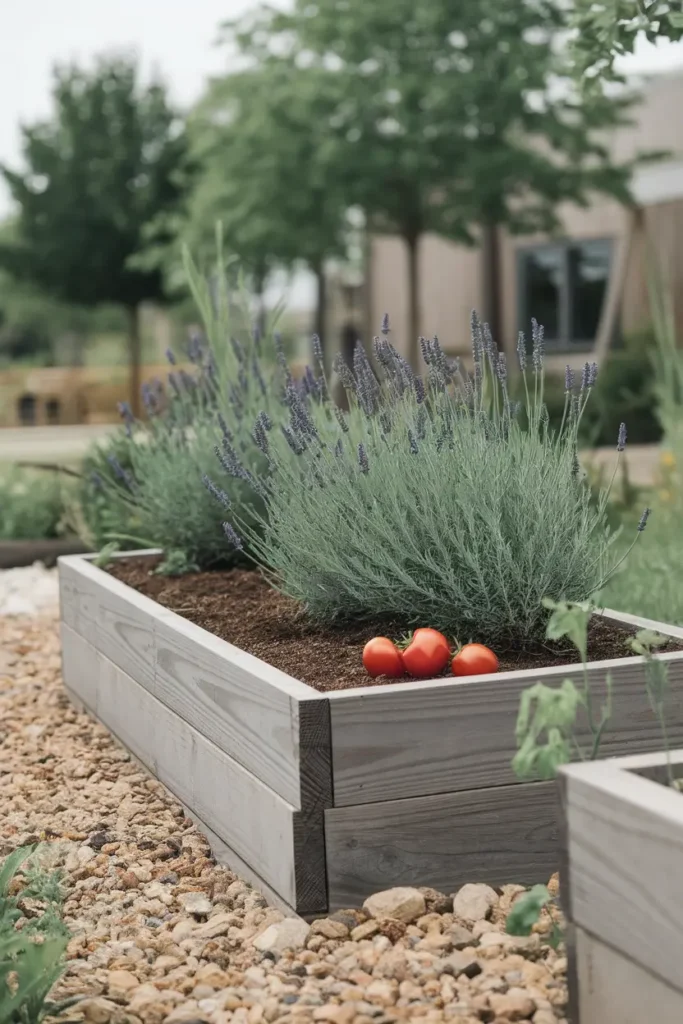
Pair lavender with vegetables like tomatoes or peppers to create a functional yet beautiful raised bed.
Lavender’s lovely floral aroma not only repels pests like aphids, moths, and mosquitoes but also attracts essential pollinators like bees and butterflies, making it a valuable addition to any garden.
Its bright purple flowers add a pop of color, transforming your raised bed into a visual delight.
Lavender is also incredibly low-maintenance and drought-tolerant, thriving even in less-than-ideal conditions.
Beyond its gardening benefits, you can harvest lavender for sachets, essential oils, or homemade crafts, making it a multi-purpose plant that enhances your garden in every way.
8. Edible Flower Bed
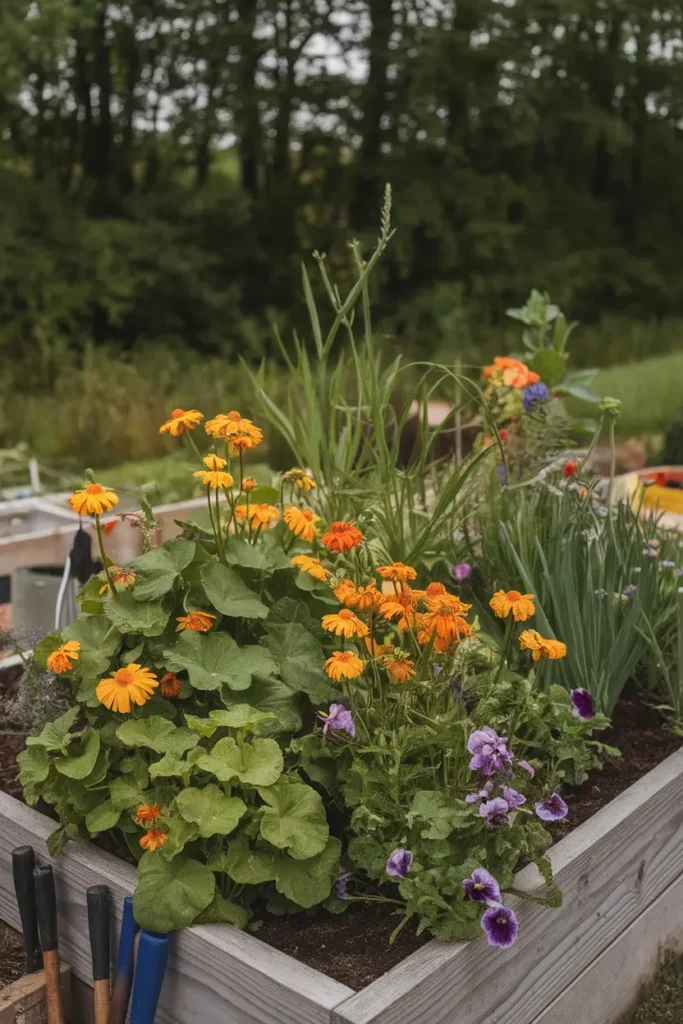
Turn your garden into a feast for the eyes and the plate by growing flowers like nasturtiums, calendula, or violets.
These edible blooms not only add vibrant colors and unique flavors to your meals but also attract pollinators and beneficial insects, creating a healthier garden ecosystem.
Sprinkle petals into salads, desserts, or drinks to add a touch of elegance and creativity to your dishes.
Edible flowers are also packed with nutrients, offering more than just beauty.
By dedicating a raised bed to these stunning blooms, you’ll enjoy a garden that’s as functional as it is gorgeous, bringing a whole new level of charm and flavor to your outdoor space.
9. Trellised Raised Beds

Maximize the potential of small spaces by incorporating trellises into your raised beds.
Vertical gardening allows plants like beans, cucumbers, peas, or even climbing flowers to thrive as they grow upward, leaving more ground space for other crops.
Trellises not only reduce the risk of pests and plant diseases by keeping foliage off the damp soil but also improve air circulation, leading to healthier plants.
Additionally, they bring a decorative touch to your garden, creating a visually appealing and productive space.
10. Mixed Polyculture Bed
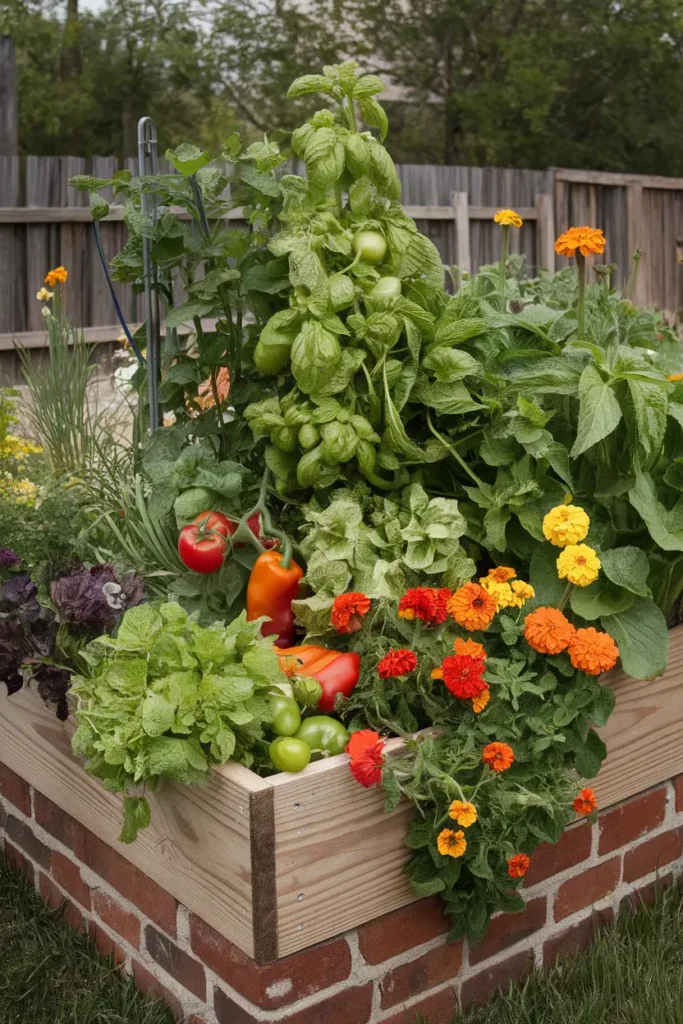
Embrace a natural, sustainable gardening approach with a mixed polyculture bed.
By planting a blend of vegetables, herbs, and flowers together, you mimic ecosystems found in nature, promoting biodiversity and enhancing soil health.
This method reduces the risk of pests as companion planting helps deter harmful insects while attracting pollinators and beneficial wildlife like bees and butterflies.
Enjoy a colorful, vibrant garden filled with a variety of fresh produce and herbs while reducing the need for chemical pest control.
11. Formal Raised Garden

Design a stunning potager (kitchen garden) with symmetrical, organized raised beds for a combination of beauty and productivity.
By using straight lines, geometric patterns, or raised garden kits, you can create a garden that reflects elegance and order.
Formal raised gardens are ideal for those who want their outdoor space to double as an ornamental feature, with the added benefit of producing fresh vegetables, herbs, or flowers.
These gardens often become the centerpiece of your yard, blending utility with a striking visual appeal.
12. Steel Raised Beds
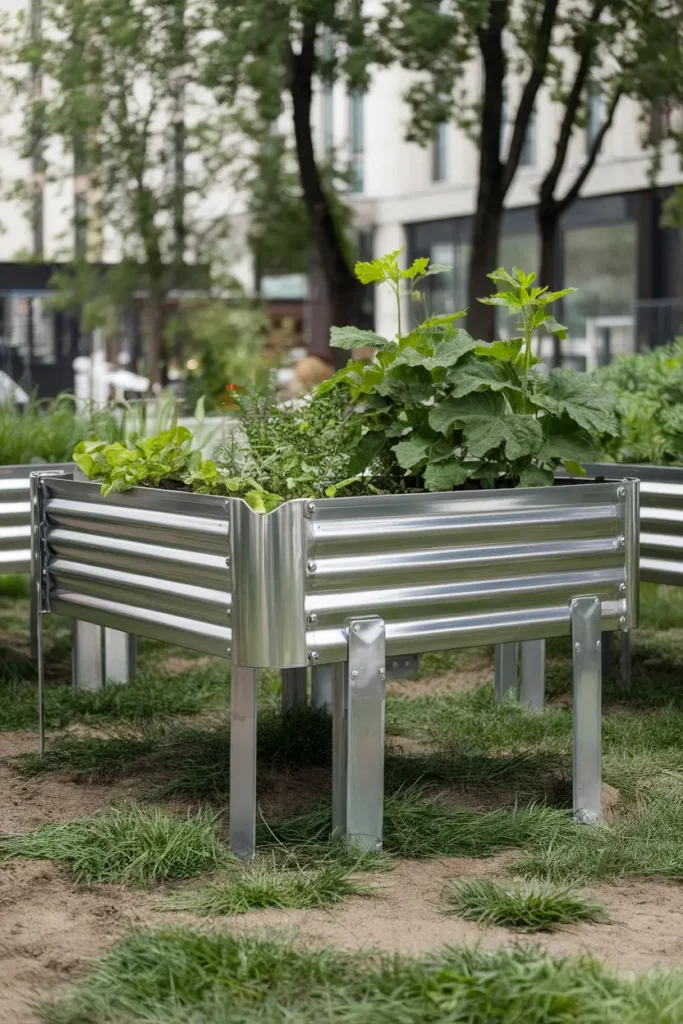
Combine strength and style with steel raised beds that are both durable and modern. Constructed to resist weathering and rust, these beds last for years, making them a wise investment for serious gardeners.
Their sleek, clean lines and industrial aesthetic make them a standout feature in any garden, whether urban or rural.
Steel raised beds are versatile and work well for growing a wide variety of plants, from leafy greens and root vegetables to vibrant decorative flowers.
They are especially useful in areas with tough soil conditions, as they provide a controlled growing environment.
13. Tiered Raised Beds

Ideal for sloped or uneven yards, tiered raised beds create cascading layers of greenery that are visually stunning and highly efficient.
This design allows you to plant taller crops like tomatoes, corn, or sunflowers at the top tier for maximum sunlight exposure, medium-height plants such as peppers, herbs, or bush beans in the middle, and shorter crops like lettuce, strawberries, or radishes at the bottom.
The tiered structure makes efficient use of water flow, as moisture naturally trickles down to lower levels, and maximizes sunlight for all plants.
It also introduces an organized, layered aesthetic to your garden.
14. Recycled Materials Bed

Go green by building raised beds using reclaimed and recycled materials like old wood, bricks, pallets, or even vintage items like bathtubs or metal troughs.
This eco-friendly approach reduces waste while adding unique character and charm to your garden.
Using recycled materials is not only sustainable but also budget-friendly, making it a great option for gardeners on a tight budget.
These beds can be customized to fit your space and style while offering a creative way to give old items a new purpose. Grow your veggies sustainably while adding a rustic or eclectic vibe to your outdoor space.
15. Kids’ Gardening Bed

Inspire the next generation of gardeners by creating a special raised bed just for kids.
Choose fast-growing, fun, and easy-to-handle plants like radishes, cherry tomatoes, strawberries, or sunflowers to keep them engaged and excited about the process.
Incorporate creative elements like colorful plant markers, stepping stones, or miniature garden accessories to make it even more fun and interactive.
Gardening helps teach kids about the importance of nature, responsibility, and patience while giving them hands-on experience with the food they eat.
A kids’ gardening bed can become a cherished space where they learn and grow alongside their plants.
Benefits of Raised Garden Beds
Before we get into the ideas, here are some reasons why raised garden beds are such a popular choice for gardening enthusiasts.
- Improved Soil Quality: Raised beds give you complete control over the soil you use, making it easier to achieve the perfect mix. Whether you need nutrient-rich soil for vegetables or well-draining soil for flowers, you’re in the driver’s seat.
- Easy Maintenance: No more bending over for hours—weeding, watering, and harvesting are much easier when your plants are elevated. This makes raised beds particularly great for those with back or knee issues.
- Better Garden Aesthetics: Raised beds can serve as design elements, adding defined structure and texture to your garden. Whether you use wood, stone, or metal containers, they can elevate your outdoor space, both literally and figuratively.
FAQs
Do raised garden beds require special soil?
Yes, it’s best to use a mix that drains well while retaining moisture. Many gardeners use a combination of topsoil, compost, and peat moss for optimal results.
How tall should raised beds be?
Most raised beds are 12 to 18 inches tall, but this depends on what you’re planting. Deeper-rooted plants like carrots may need taller beds.
What materials are best for building raised beds?
Wood is a popular option, especially cedar or redwood, as they resist rot. Metal and stone are durable alternatives, while wicker adds a rustic touch.
Conclusion
Raised garden beds aren’t just about growing plants; they’re about maximizing your gardening potential.
Either you’re looking for functional solutions or aesthetic upgrades, these ideas prove that gardening is both an art and a science.
Why wait? Start building your raised bed today and transform your outdoor space into a flourishing haven.
